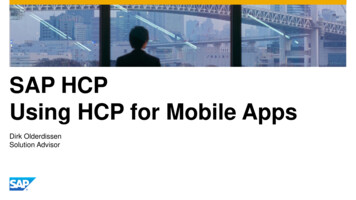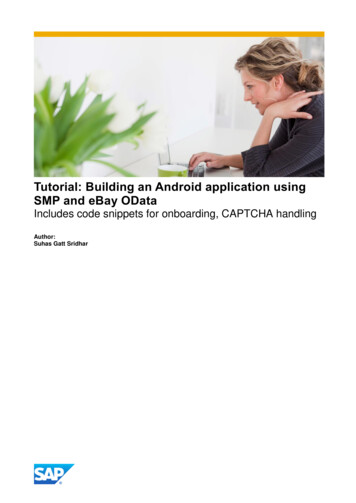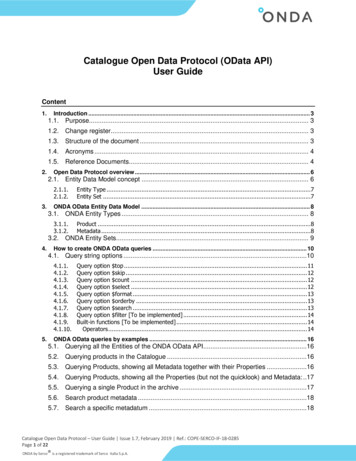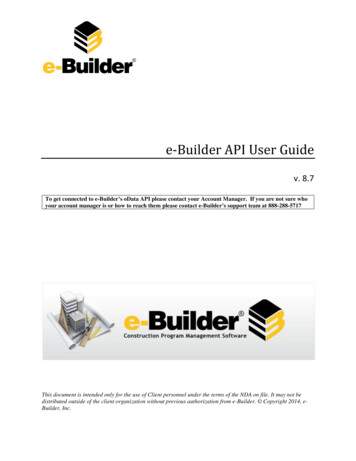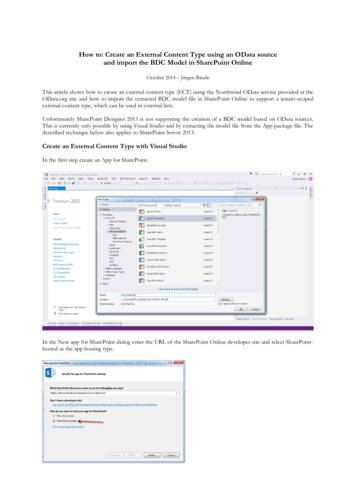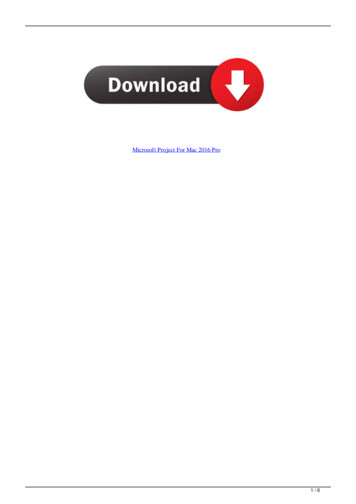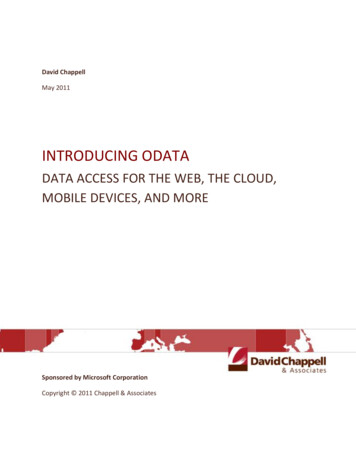
Transcription
David ChappellMay 2011INTRODUCING ODATADATA ACCESS FOR THE WEB, THE CLOUD,MOBILE DEVICES, AND MORESponsored by Microsoft CorporationCopyright 2011 Chappell & Associates
ContentsDescribing OData . 3The Problem: Accessing Diverse Data in a Common Way .3The Solution: What OData Provides .3How OData Works: Technology Basics .5Using OData: Example Scenarios . 6Accessing Application Data from Mobile Phones and Web Browsers .6Exposing Data from a Cloud Application .8Using Diverse Data Sources with Different BI Tools .9Examining OData: A Closer Look at the Technology and Its Implementation . 10The OData Data Model .10The OData Protocol .12Protocol Basics .13Serializing Data with Atom/AtomPub .13Serializing Data with JSON .19Issuing Queries .20A Perspective: OData in a SOA World .21OData Client Libraries .22OData Services .22Conclusion . 23For Further Reading . 24About the Author . 242
Describing ODataOur world is awash in data. Vast amounts exist today, and more is created every year. Yet data has value only if itcan be used, and it can be used only if it can be accessed by applications and the people who use them.Allowing this kind of broad access to data is the goal of the Open Data Protocol, commonly called just OData. Thispaper provides an introduction to OData, describing what it is and how it can be applied. The goal is to illustratewhy OData is important and how your organization might use it.The Problem: Accessing Diverse Data in a Common WayThere are many possible sources of data. Applications collect and maintain information in databases, organizationsstore data in the cloud, and many firms make a business out of selling data. And just as there are many datasources, there are many possible clients: Web browsers, apps on mobile devices, business intelligence (BI) tools,and more. How can this varied set of clients access these diverse data sources?One solution is for every data source to define its own approach to exposing data. While this would work, it leadsto some ugly problems. First, it requires every client to contain unique code for each data source it will access, aburden for the people who write those clients. Just as important, it requires the creators of each data source tospecify and implement their own approach to getting at their data, making each one reinvent this wheel. And withcustom solutions on both sides, there’s no way to create an effective set of tools to make life easier for the peoplewho build clients and data sources.Thinking about some typical problems illustrates why this approach isn’t the best solution. Suppose a Webapplication wishes to expose its data to apps on mobile phones, for instance. Without some common way to dothis, the Web application must implement its own idiosyncratic approach, forcing every client app developer thatneeds its data to support this. Or think about the need to connect various BI tools with different data sources toanswer business questions. If every data source exposes data in a different way, analyzing that data with varioustools is hard—an analyst can only hope that her favorite tool supports the data access mechanism she needs to getat a particular data source.Defining a common approach makes much more sense. All that’s needed is agreement on a way to model data anda protocol for accessing that data—the implementations can differ. And given the Web-oriented world we live in, itwould make sense to build this technology with existing Web standards as much as possible. This is exactly theapproach taken by OData.The Solution: What OData ProvidesOData defines an abstract data model and a protocol that let any client access information exposed by any datasource. Figure 1 shows some of the most important examples of clients and data sources, illustrating where ODatafits in the picture.3
Figure 1: Any OData client can access data provided by any OData data source.As the figure illustrates, OData allows mixing and matching clients and data sources. Some of the most importantexamples of data sources that support OData today are:Custom applications: Rather than creating its own mechanism to expose data, an application can instead useOData. Facebook, Netflix, and eBay all expose some of their information via OData today, as do a number ofcustom enterprise applications. To make this easier to do, OData libraries are available that let .NETFramework and Java applications act as data sources.Cloud storage: OData is the built-in data access protocol for tables in Microsoft’s Windows Azure, and it’ssupported for access to relational data in SQL Azure as well. Using available OData libraries, it’s also possibleto expose data from other cloud platforms, such as Amazon Web Services.Content management software: For example, SharePoint 2010 and Webnodes both have built-in support forexposing information through OData.Windows Azure Marketplace DataMarket: This cloud-based service for discovering, purchasing, and accessingcommercially available datasets lets applications access those datasets through OData.While it’s possible to access an OData data source from an ordinary browser—the protocol is based on HTTP—client applications usually rely on a client library. As Figure 1 shows, the options supported today include:Web browsers: JavaScript code running inside any popular Web browser, such as Internet Explorer or Firefox,can access an OData data source. An OData client library is available for Silverlight applications as well, andother rich Internet applications can also act as OData clients.4
Mobile phones. OData client libraries are available today for Android, iOS (the operating system used byiPhones and iPads), and Windows Phone 7.Business intelligence tools: Microsoft Excel provides a data analysis tool called PowerPivot that has built-insupport for OData. Other desktop BI tools also support OData today, such as Tableau Software’s TableauDesktop.Custom applications: Business logic running on servers can act as an OData client. Support is available todayfor code created using the .NET Framework, Java, PHP, and other technologies.The fundamental idea is that any OData client can access any OData data source. Rather than creating unique waysto expose and access data, data sources and their clients can instead rely on the single solution that ODataprovides.OData was originally created by Microsoft. Yet while several of the examples in Figure 1 use Microsofttechnologies, OData isn’t a Microsoft-only technology. In fact, Microsoft has included OData under its OpenSpecification Promise, guaranteeing the protocol’s long-term availability for others. While much of today’s ODatasupport is provided by Microsoft, it’s more accurate to view OData as a general purpose data access technologythat can be used with many languages and many platforms.How OData Works: Technology BasicsProviding a way for all kinds of clients to access all kinds of data is clearly a good thing. But what’s needed to makethe idea work? Figure 2 shows the fundamental components of the OData technology family.Figure 2: An OData service exposes data via the OData data model, which clients access with an OData clientlibrary and the OData protocol.The OData technology has four main parts:5
The OData data model, which provides a generic way to organize and describe data. OData uses the Entity1Data Model (EDM), the same approach that’s used by Microsoft’s Entity Framework (EF) .The OData protocol, which lets a client make requests to and get responses from an OData service. At bottom,the OData protocol is a set of RESTful interactions—it’s just HTTP. Those interactions include the usualcreate/read/update/delete (CRUD) operations, along with an OData-defined query language. Data sent by anOData service can be represented on the wire today either in the XML-based format defined byAtom/AtomPub or in JavaScript Object Notation (JSON).OData client libraries, which make it easier to create software that accesses data via the OData protocol.Because OData relies on REST, using an OData-specific client library isn’t strictly required. But most ODataclients are applications, and so providing pre-built libraries for making OData requests and getting resultsmakes life simpler for the developers who create those applications.An OData service, which exposes an endpoint that allows access to data. This service implements the ODataprotocol, and it also uses the abstractions of the OData data model to translate data between its underlyingform, which might be relational tables, SharePoint lists, or something else, into the format sent to the client.Given this basic grasp of the OData technology, it’s possible to get a better sense of how it can be used. The bestway to do this is to look at some representative OData scenarios.Using OData: Example ScenariosBecause OData is a general-purpose data access mechanism, it can be used in many different ways. This sectionlooks at three representative examples:Using OData to let mobile phones and Web browsers access a custom application’s data.Letting application business logic use OData to access data exposed in the cloud.Allowing different BI tools to access diverse data sources through OData.Accessing Application Data from Mobile Phones and Web BrowsersUsers commonly access Web applications today through browsers. More and more, however, custom clientapplications are used in place of browsers, especially on mobile devices. And when those client apps need toaccess a Web application’s functionality, using standard REST calls can work well.But exposing data is harder. Without conventions for doing this, the creator of a Web application needs to create adata model (since he probably doesn’t want to expose his application’s internal database structure to the world), aquery language (to allow more than just simple reads), client libraries (to help diverse clients access the data), andperhaps even tools (to help people create those clients).1Even though the EDM was originally created as part of Entity Framework, OData borrows just the EDM modelingaspect of EF. An implementation of OData isn’t required to use EF itself.6
If the application instead exposes its data through OData, life gets significantly simpler—these things are alreadyavailable. Figure 3 illustrates this, showing how a custom application can use OData to expose its data both toclient apps on mobile phones and to Web browsers.Figure 3: Mobile phones and Web browsers can use OData to access data exposed by a custom application.In this example, data exposed by a Web application is accessed by client apps running on three different kinds ofmobile devices: Android, iPhone/iPad, and Windows Phone 7. All three rely on OData client libraries madeavailable by Microsoft today, and all three see the same data model exposed by the custom application’s ODataservice. When requesting data via the OData protocol, each application can choose the format it wants that datadelivered in: XML with Atom/AtomPub or JSON.Similarly, JavaScript code running in a Web browser uses another Microsoft-provided OData client library to accessthe application’s data. The data is exposed using the same data model, and it’s accessed via the same ODataprotocol. Because the client is written in JavaScript, it probably elects to have data delivered to it in JSON (althoughthis isn’t required). And although it’s not shown in the figure, Microsoft also provides an OData client library forSilverlight, supporting more functional browser applications.It’s important to understand that nothing about OData requires an application to expose the structure of itsinternal data to clients. A client only sees the data model provided by the OData service, not the raw underlyingdata. How the application maps its data to the OData data model is entirely up to the developer. If the underlyingdata source is relational tables, for example, she might choose to reflect one or more tables directly in herapplication’s OData data model, but perhaps omit some of columns in these tables. Alternatively, she might createan entirely different mapping where the OData data model is quite different from the underlying database.7
Whatever choice she makes, the OData service is free to interpose logic, such as rules for access control, betweenclients and that data. Using OData needn’t mean that clients can see directly into the structure of an application’sdata.It’s also important to understand that OData is designed to protect data sources from clients that request toomuch data. As long as clients request small amounts of data, this problem doesn’t arise. But suppose a clientrequests all of the data in, say, a relational table—what then? Is the OData service obligated to return everythingin a single response? The answer is no. Instead, a service is free to define its own page size, then return data apage at a time. It can also provide a continuation indicator, letting the client request the next page. Because ofthis, a client request for a large amount of data needn’t overwhelm an OData service’s ability to deal with it.Exposing Data from a Cloud ApplicationCloud platforms are changing how we build and run applications. They’re also changing how we store and accessdata. OData can play a role in these changes.For example, think about a firm that sells products directly to customers via the Web. Suppose this firm also wishesto let partner organizations access its product information from their own applications. To do this, the firm mightbuild an application and store its data on a cloud platform, such as the Windows Azure platform. This cloudapplication will interact with users via browsers as usual. It can also use OData to expose the application’s data tosoftware created by its partners. Figure 4 shows how this looks.Figure 4: Diverse applications can use OData to access data stored in the cloud.8
As the figure shows, the Windows Azure application interacts with customers via browsers. This application mightbe built using the .NET Framework or Java or something else—Windows Azure supports several options. Whateverlanguage it’s in, the application can expose an OData service to provide external access to its data. In this example,partners have created applications using PHP and Java, both of which have OData client libraries available. Thesepartner applications then interact with their own users through browsers or perhaps in some other way, accessingthe cloud data as needed. This approach, with an application providing a standard browser interface while alsoexposing its data to other applications, is a common way to use OData today.A partner application can also use OData to access information that the cloud application stores in Windows Azuretables, as Figure 4 illustrates. OData is the native access protocol for Windows Azure tables, and as long as it’sauthorized to do so, another application can work directly with this information. It’s more common today toexpose an OData service from an application rather than directly from a data store, but both approaches arepossible.Using Diverse Data Sources with Different BI ToolsBusiness intelligence, analyzing information to extract meaning, is an important part of how people use data.Analyzing data first requires accessing data, and given the multiplicity of BI tools and data sources in use today, thisis a non-trivial problem. Different analysts prefer different tools, and data is kept in different forms in differentplaces. Much of an organization’s useful data is likely to be wrapped inside custom and packaged applications, forexample, while many organizations also keep useful business data in SharePoint lists. Another possible source fordata is Microsoft’s Windows Azure Marketplace DataMarket, which provides a cloud-based way to purchase andaccess commercial data sets.Suppose an analyst wishes to combine data from these various sources. Maybe a retailer is trying to decide whereto locate a new store, for example, and so needs to look at sales information from one of its custom applications,customer survey data stored in SharePoint lists, and demographic data acquired from DataMarket. Or perhapsanalysts in a local government wish to access emergency call data from the city’s custom call center application,police reports stored in SharePoint, and national crime statistics available through DataMarket. In both cases, it’sentirely possible that different analysts wish to use different tools to work with this data.The problem is clear: How can we connect multiple clients to multiple data sources? Without a common approachto exposing and accessing data, the situation is bleak. OData can help, as Figure 5 shows.9
Figure 5: Different BI tools can use OData to access data stored in different formats across different datasources.In this example, two different analysts using different BI tools—Tableau Desktop and Microsoft Excel’sPowerPivot—are accessing data from the three data sources just listed: SharePoint 2010 lists, a customapplication, and Windows Azure Marketplace DataMarket. All of these technologies can use OData today, and somaking these connections is straightforward. Because clients and data sources speak the common language ofOData, hooking them together gets simpler, and analysts can begin working with new data more rapidly.Examining OData: A Closer Look at the Technology and Its ImplementationOData began life as a Microsoft project code-named Astoria. The technology was then renamed ADO.NET DataServices before its protocol and data model were separated out and became OData. (The parts of ADO.NET DataServices that were focused on the Windows implementation of OData are now known as WCF Data Services.)Whatever the name, though, the fundamental technology of OData has remained the same.As described earlier, it’s useful to think about the OData world in four parts: the data model, the protocol, theclient libraries, and the OData service itself. This section describes all four, beginning with the data model.The OData Data ModelTo provide a general way for any client to access any kind of information, OData provides an abstract data model.Yet data comes in many different forms, and it can be related to other data in a variety of ways. How can a singledata model encompass this diversity?OData’s answer is the Entity Data Model. In many ways a modern take on the familiar entity-relationship model,the EDM models data as entities and associations among those entities. This general approach lets the EDM—and10
thus OData—work with pretty much any kind of data. Figure 6 illustrates the fundamentals of how the EDMdescribes data.Figure 6: The Entity Data Model describes data as entities connected by associations.As the figure shows, associations between entities can be one-to-one or many-to-one. An association can also beunidirectional, as are most of those shown here, or bi-directional, like the association in the upper right. Whateverstructure is used, it’s important to understand that the EDM describes only the logical structure of data. How thatdata is stored physically is irrelevant.The data exposed by an OData service can come from many sources, and how this data is mapped to the EDM is upto the creator of that service. For example, an OData service exposing relational data might represent each table asan entity, with foreign key relationships among those tables modeled as associations. A service that’s exposingdata directly from a set of Java objects might model each object as an entity and the connections among objects asassociations.There’s more to the EDM than just entities and associations, however. Figure 7 shows a more complete picture.11
Figure 7: In the EDM, an entity container holds entity sets, while each entity has one or more properties.As the figure shows, the EDM organizes entities into a simple hierarchy. Each entity is part of an entity set, andeach entity set belongs to an entity container. Entities, each of which is of some entity type, also have a simplestructure: They contain properties, each of which contains data that this entity holds. To describe the data inproperties, the EDM defines a variety of data types, such as String, Boolean, Int16, Int32, Binary, and DateTime.Special properties called navigation properties represent associations—they implement connections betweenentities. In the example show here, for example, each entity set might be a table in a relational database, witheach entity a row in that table. Navigation properties represent relationships between rows, such as thoseexpressed by foreign keys.Having a general model for all kinds of data is essential. Without it, OData couldn’t give clients a common view ofdiverse data sources. Useful as it is, though, the EDM isn’t enough. There must also be a way for an OData client tosend requests to an OData service, then get data back. The OData protocol defines how to do this, as describednext.The OData ProtocolThe OData protocol is based on REST; at bottom, it’s just HTTP. But HTTP alone isn’t enough. OData also defineshow data modeled using the EDM should look on the wire, how to form queries against that data, and more. Thissection takes a closer look at these aspects of the technology.12
Protocol BasicsAn OData client accesses data provided by an OData service using standard HTTP. The OData protocol largelyfollows the conventions defined by REST, which define how HTTP verbs are used. The most important of theseverbs are:GET: Reads data from one or more entities.PUT: Updates an existing entity, replacing all of its properties.2MERGE: Updates an existing entity, but replaces only specified properties .POST: Creates a new entity.DELETE: Removes an entity.As usual with REST, each HTTP request is sent to a specific URI, identifying some point in the target OData service’sdata model. For example, the root URI for a service might be www.fabrikam.com/example.A client can typically learn about the data model used by an OData service by issuing a GET on a service’s root URIwith “ metadata” appended to it. For example, issuing the HTTP requesthttp://GET www.fabrikam.com/example/ metadatareturns a description of the EDM schema for the data model exposed by this OData service. The returned schemais expressed in an XML-based format called the conceptual schema definition language (CSDL), and an OData clientcan examine it to see what the service’s data model looks like.Like most data access protocols, OData must handle authentication: How does a client prove its identity to anOData service? The answer is that since OData is based on REST, any authentication scheme that works in aRESTful context will work here. For straightforward interactions, communication between OData clients andservices can rely on HTTP Basic Authentication over SSL. For more complex scenarios, Microsoft recommends usingOAuth 2.Serializing Data with Atom/AtomPubThe purpose of the OData protocol is to let a client get data from an OData service. While the EDM defines anabstract data model, it says nothing about how that data should be serialized, i.e., how it should be represented onthe wire. To fill this gap, OData today defines two serialization options: one using the XML-based Atom/AtomPuband another using JSON. Both are worth looking at, beginning with the more commonly used Atom/AtomPub.Atom, defined in RFC 4287, was originally created to describe information in blogs. It models a blog as a feed thatprovides data to its readers. Each feed contains some number of entries, each of which holds the content of a2MERGE is a custom HTTP method added by OData’s creators. Since then, RFC 5789 has defined the PATCHmethod to provide the same functionality. The next version of OData will support both MERGE and PATCH.13
particular blog entry. AtomPub, officially known as the Atom Publishing Protocol, defines the notion of a servicethat contains one or more collections. It also defines a set of RESTful interactions for accessing a service.Taken together, Atom and AtomPub define a hierarchical model for data, as Figure 8 shows.Figure 8: Atom and AtomPub together define an XML representation of data organized into a hierarchy.In the Atom/AtomPub world, each collection is mapped to a feed. For a client to learn what blogs a particular sitemakes available, it can ask the AtomPub service for the collections it contains, then access the feed that eachcollection represents. The Atom and AtomPub specifications define how to represent this in XML, providing aconcrete way to send information across the network.All of this raises an obvious question: What does a data model originally created for blogs have to do with the kindof general purpose data access that OData allows? The answer is that from its humble blog origins, Atom/AtomPubhas grown into a widely used approach for working with a variety of data on the Web. (In fact, the creators ofAtomPub explicitly intended to design something that would be more broadly useful.) Given this popularity,OData’s creators chose to adopt it for an XML serialization format rather than create something new.Like the EDM, Atom/AtomPub organizes information into a hierarchy: A service contains collections, each of whichcorresponds to a feed, with each feed containing entries. Mapping the EDM to Atom/AtomPub is straightforward,as Figure 9 shows.14
Figure 9: OData can use Atom/AtomPub to serialize EDM-defined data for transmission across the wire.As the figure shows, an AtomPub service corresponds to an entity container in EDM. An AtomPub collection,together with the Atom feed it’s associated with, is mapped to an EDM entity set. An Atom entry corresponds toan EDM entity, while both hierarchies represent actual data values as properties. (Atom doesn’t define properties,however—this is an extension added by OData.)To get a concrete sense of how these abstractions are used, think about how an OData service might map data in arelational database first into the EDM, then into Atom/AtomPub for transmission to a client. Figure 10 summarizesthe relationships.15
Figure 10: Relational data can be mapped first to the EDM, then to Atom/AtomPub for transmission to an ODataclient.Like the EDM and Atom/AtomPub, a relational database organizes data into a hierarchy. At the top is the databaseitself, which contains tables. Each table holds some number of rows, while each row contains a set of columnvalues. Mapping this to the EDM and Atom/AtomPub, the database itself corresponds to an EDM entity container,then to an AtomPub service. Each table becomes an EDM entity set, represented as an AtomPub collection and anAtom feed. Each row in the table is an EDM entity and an Atom entry, while each column value becomes aproperty in both EDM and Atom.To understand how this actually looks on the wire, it’s useful to walk through an example. Figure 11 shows asimple relational database with two tables: Customers and Orders. Both tables have three columns, and both areexposed by an OData service with the URI www.fabrikam.com/example. To begin accessing the data thisservice provides, an OData client can issue an HTTP GET on this URI, as Figure 11 shows.16
Figure 11: Issuing a GET on the base URI of an OData service returns an AtomPub service document describingthe collections (i.e., the feeds) in that service.The result of this GET is an AtomPub service document. As its name suggests, a s
Other desktop I tools also support OData today, such as Tableau Software's Tableau Desktop. Custom applications: Business logic running on servers can act as an OData client. . query language (to allow more than just simple reads), client libraries (to help diverse clients access the data), and perhaps even tools (to help people create .
